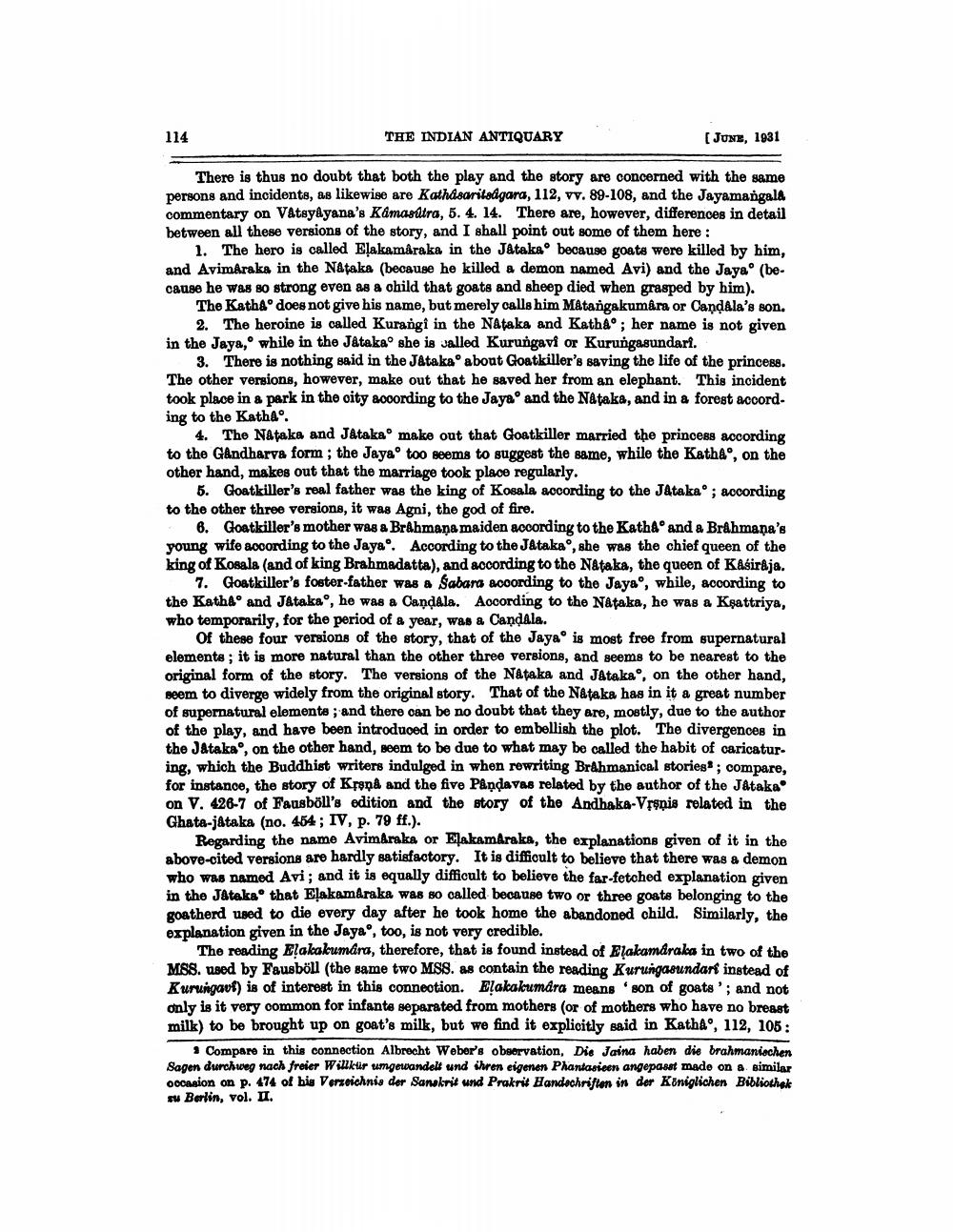________________
114
THE INDIAN ANTIQUARY
[JUNE, 1931
There is thus no doubt that both the play and the story are concerned with the same persons and incidents, as likewise are Kathasaritságara, 112, vv. 89-108, and the Jayamangala commentary on Våtsyêyana's Kamasutra, 5. 4. 14. There are, however, differences in detail between all these versions of the story, and I shall point out some of them here:
1. The hero is called Eļakamaraka in the J&takao because goats were killed by him, and AvimAraka in the Nataka (because he killed a demon named Avi) and the Jayao (because he was so strong even as a child that goats and sheep died when grasped by him).
The Kathao does not give his name, but merely calls him Matangakumara or Candala's son.
2. The heroine is called Kurangi in the Nataka and Kathao; her name is not given in the Jaya,' while in the Jatakao she is called Kurungavi or Kurungasundari.
3. There is nothing said in the J&takao about Goatkiller's saving the life of the princess. The other versions, however, make out that he saved her from an elephant. This incident took place in a park in the city according to the Jayao and the Nataka, and in a forest according to the Kath&o.
4. The Nataka and Jatakao make out that Goatkiller married the princess according to the Gandharva form; the Jayao too seems to suggest the same, while the Kath&, on the other hand, makes out that the marriage took place regularly.
5. Goatkiller's real father was the king of Kosala according to the J&takao ; according to the other three versions, it was Agni, the god of fire.
6. Goatkiller's mother was a Brahmana maiden according to the KathA and a Brahmana's young wife according to the Jaya'. According to the Jatakao, she was the chief queen of the king of Kosala (and of king Brahmadatta), and according to the Nataka, the queen of Kasirkja.
7. Goatkiller's foster-father was a Sabard according to the Jayao, while, according to the Kath&o and J&takao, he was a Candala. According to the Nataka, he was a Kşattriya, who temporarily, for the period of a year, was a Candala.
Of these four versions of the story, that of the Jayao is most free from supernatural elements ; it is more natural than the other three versions, and seems to be nearest to the original form of the story. The versions of the Nataka and J&takao, on the other hand, seem to diverge widely from the original story. That of the Nataka has in it a great number of supernatural elemente ; and there can be no doubt that they are mostly, due to the author of the play, and have been introduoed in order to embellish the plot. The divergences in the Jataka', on the other hand, seem to be due to what may be called the habit of caricatur. ing, which the Buddhist writers indulged in when rewriting Brahmanical stories; compare, for instance, the story of Kroņ& and the five Pandavas related by the author of the Jataka on V. 426-7 of Fausböll's edition and the story of the Andhaka-Vrenis related in the Ghata-játaka (no. 454 ; IV, p. 79 ff.).
Regarding the name AvimAraka or Elakamêraka, the explanations given of it in the above-cited versions are hardly satisfactory. It is difficult to believe that there was a demon who was named Avi; and it is equally difficult to believe the far-fetched explanation given in the Jatakao that Eļakamaraka was so called because two or three goats belonging to the goatherd used to die every day after he took home the abandoned child. Similarly, the explanation given in the Jaya", too, is not very credible.
The reading Elakakumara, therefore, that is found instead of Elakamaraka in two of the MSS. used by Fausböll (the same two MSS. as contain the reading Kurungasundarf instead of Kurungavt) is of interest in this conneotion. Elakakumdra means son of goats'; and not only is it very common for infants separated from mothers (or of mothers who have no breast milk) to be brought up on goat's milk, but we find it explicitly said in Katha', 112, 105 :
Compare in this connection Albrecht Weber's observation, Die Jaina haben die brahmanischen Sagen durchweg nach freier Willktir umgewandelt und ihren eigenen Phantasieen angepasst made on a similar occasion on p. 474 of bis Verzeichnis der Sanskrit und Prakrit Handschriften in der Königlichen Bibliothek su Berlin, vol. II.




